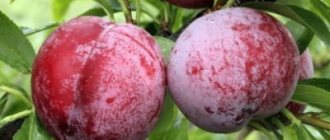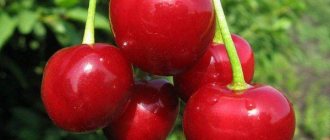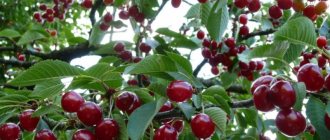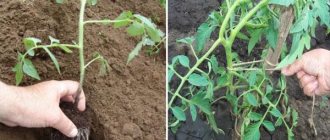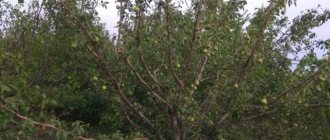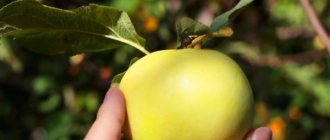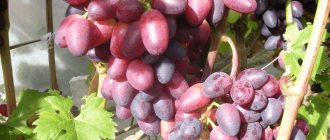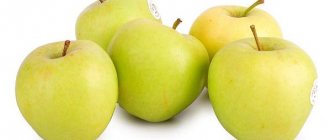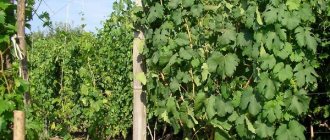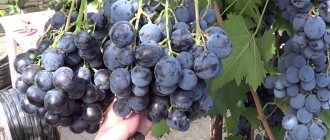Gardening » Apple tree
2
1179
Article rating
Kira Stoletova
The White Rose apple tree variety is a subspecies of the Chompu (Malobar plum) culture, originally from Malaysia. This tree has unique quality characteristics and history. The apple tree is unpretentious in care - it quickly takes root in Russia.
Features of the White Rose apple tree
Description and characteristics of the variety
The White Rose apple tree variety is not quite an apple tree and even more so far from a rose. This is an evergreen shrub plant with large growth and large leaves. A crop with an unusual shape of fruits, which are more like pears or roses of a beautiful color, having a sourish and rather unusual taste, with a share of sugar.
Unripe green apples.
Advantages and disadvantages of the variety
The unusual apple crop has a number of positive properties.
Among them:
- taste qualities of fruits;
- versatility of fruit use;
- presentable appearance of fruit;
- balanced composition of pulp;
- presence of essential oils.
The shelf life of the fruits is not very long, so they must be used immediately. But the amazing taste easily harmonizes in salads, jams and preserves.
Description of the tree
An apple tree can be a spreading shrub or a tall tree, more like a vine. The trunk is small in diameter, the crown is quite thick and voluminous, and looks very decorative. The leaves are glossy, long, lanceolate, on small petioles.
The unusual Java apple can be seen in the photo.
Properties of fruits
The White Rose apple tree is an unusual crop. The fruit tastes very pleasant, sweet and sour, and may vary slightly depending on the subspecies.
An amazing property of the fruit is the versatility of its use. In their homeland they are used to relieve thirst: they are so juicy, they look like watermelon, and the skin is crispy. They are used to make sweets, canned, cooked with meat or added to salad.
Flowering and fruiting times
The apple tree blooms profusely and very unusually in early spring. White flowers gather at the top and become large inflorescences.
If an unusual crop is grown in tropical conditions or in greenhouses, then it can bloom twice per season. Fruit sets after 3 months.
Resistance of the variety to cold and disease
In most regions of Russia, growing such a decorative and unusual variety of apple tree is impossible. White rose is very picky about growing temperatures. It feels comfortable in tropical climates and tolerates drought conditions more easily than low temperatures. In temperate climate zones, the variety can only be grown in greenhouses or containers. Already when the temperature drops to +5, the apple tree stops growing and developing.
Placing the apple tree in a container. The plant is quite dense and spreading. This structure makes it susceptible to scab and powdery mildew. When growing, it is necessary to additionally protect against fungus.
Main pollinators of the variety
The White Rose apple tree is self-pollinating. During flowering, pollen is transferred from the male to the female flower with the help of wind and insects. In this way, the ovaries are formed, from which the fruits will form.
Harvest and storage
The fruits of the White Rose apple are harvested several times per season if the plant is grown in greenhouse conditions. The fruits are picked ripe so that they can be consumed fresh. They are not stored for long-term storage, as they are too tender and quickly spoil even in the refrigerator.
The water apple is of no commercial or industrial interest to our gardeners. This exotic plant is planted more out of curiosity - it is interesting to grow an apple tree with fruits that are completely different from ordinary apples.
0
0
Copy link
Landing Features
For planting, a number of conditions must be met. The soil should be loose and fertilized. The seat is well lit, the temperature is room temperature.
Optimal timing
The most common and convenient time for planting is spring, before the start of the growing season. But even when planting in the fall, there will be no restrictions or changes in planting conditions.
Rules for choosing a seedling when planting
When buying a seedling, you need to pay attention to its external condition. It should not show signs of damage to the red-brown bark or root system. The size of a seedling of the correct size does not exceed 20-25 cm.
Apple tree seedlings.
Preparing the landing site
If planting will take place in a container, and most often this happens in Russian conditions, a nutrient mixture must be placed in it. You will need to use humus, river sand and sphagnum moss in equal proportions. The place where the container with the seedling will stand should be on the south side so that the plant receives enough light and heat.
Advantages and disadvantages
Apples of the White Rose variety have a unique, delicate taste. When ripe they emit a strong spicy aroma.
This is one of the advantages of fruits - taste. They are grown for sale because they have a presentable appearance. The variety is universal in use. Fruit purees, compotes, and jams are prepared from the pulp.
The fruit is consumed raw, and there is no need to wait for it to rest. The pulp adds piquancy to any salad - thanks to its taste, you can combine salty and sweet ingredients.
The variety is used to obtain beneficial essential oils. Unlike other garden crops, White Rose is famous for the composition of its fruits - it is not only balanced, but also very healthy. The low calorie content of the product is another advantage: 100 g of the product contains only 25 kcal.
The variety has few disadvantages. Healthy fruits do not last too long and should be used immediately after harvesting.
Features of care
An interesting feature and varietal advantage of the White Rose is that it gets along quite well with people in the same microclimate. There are several simple maintenance requirements: fertilizing, pruning and watering.
Soil care
If climatic conditions allow the crop to be grown in open ground, then the young seedling will need to be acclimatized. It must be taken outside briefly for two weeks, and only then planted.
The process of loosening the soil.
A planted apple tree needs loosening and cleaning of the tree trunk.
Feeding and watering
Natural growing conditions are associated with high humidity. Therefore, moisture must be added regularly. If conditions permit, Chompa is watered using the drip method. The water must be settled or rainwater and cannot be used directly from the tap.
Fertilizers are applied at the root, but away from the trunk. In spring and summer, organic matter is needed, during the hot season and closer to spring, mineral fertilizers are needed. You can combine watering and fertilizing.
Pruning and crown formation
The pruning and shaping procedure is combined and carried out in the fall, after flowering. You need to remove broken shoots, shorten the growth and cut off the top.
Preparing for winter
The Malobar plum grown in a container is prepared for winter simply - it is brought into a warm room.
If the crop is grown outdoors in a warm climate, then in preparation for cold weather you need to mulch the tree trunk and cover the trunk with warm material using the technique of covering grapes.
Prevention of diseases and pests
The apple tree has dense leaves with a thick skin that pests cannot bite through. Therefore, the White Rose itself is protected from harmful sucking insects.
Rust on apple tree leaves.
But additional protection will be needed from diseases. This member of the myrtaceae often suffers from myrtle rust, a fungal disease that spreads very quickly. It must be combated immediately with the help of fungicides.
Golden
PROS:
- The type of fruiting is characterized as mixed
- The harvest is regular
- Apples reach medium and large sizes, up to 170 g
- The structure of the pulp is soft, juicy, and has a dessert taste.
- Collection can be done in September
- Increased winter hardiness, productivity
- The taste characteristics are excellent
- Fruits are not afraid of transportation over long distances
- They have sufficient shelf life, up to three months
- Early fruiting period, for 3 years
MINUSES:
- The need for careful and high-quality pruning
- There is a need for fruit thinning
- Their tendency to wither
- Self-sterility, requiring additional pollination
- Recommended pollinators: Wagner's Prize, Jonathan, Delicious Spur, Kuban
- Poor resistance to powdery mildew
It is popular among gardeners; it is chosen because of its ability to withstand severe frosts, excellent consumer qualities and early fruiting period.
Growing garden blackberries - a description from purchasing a seedling and planting it in open ground to caring for and harvesting from the Moscow region to Siberia (Photo & Video) + Reviews
Advice from experienced gardeners
It is possible to grow tropical crops at home, but this will require some effort. Experienced gardeners are already sharing their results and achievements:
- The planting location should be sunny, this is important for flowering.
- The site should have slightly acidic soil.
- It is best to hold the seedling by the roots when planting, because the trunk is very easy to confirm.
- Java apples often make beautiful hedges.
Of course, exotics require care and conditions; not everyone can grow them.
Planting dates and scheme
For planting, it is recommended to choose healthy and strong seedlings that have a branched root system and 2-3 strong side shoots. Young trees that are no more than 2 years old take root best on the site.
The timing of planting depends on the climatic conditions of the growing region:
- in regions with moderately cold and snowy winters, planting is carried out in the second half of September or early October;
- autumn planting of apple trees should be carried out at least a month before the first frost;
- in areas with harsh winters (air temperature below -20°C), trees are planted in the area in early spring - in April, before the buds open.
Important! 2 days before planting in a permanent place, the roots of the seedling are immersed in a container of water, and before planting, they are dipped in a viscous mixture of cow dung, water and clay.
Planting holes for young trees begin to be prepared at least 2 weeks before planting so that the soil in them is well settled. The diameter of the hole should be about 1 m, and the depth should be up to 80 cm. To ensure that the trees have enough free space to grow, a distance of about 6–7 m is left between neighboring seedlings.
1 - top fertile soil layer; 2 - top fertile layer of soil with the addition of humus and mineral fertilizers; 3 - layer of soil without fertilizers; 4 - root collar (place of transition of the root system into the trunk)
A step-by-step algorithm for planting a Melba apple tree is presented below:
- The land obtained by digging a planting hole is divided into 2 parts. To one of them add equal proportions of sand, peat and compost, as well as 1 liter of ash, 400 g of superphosphate and 200 g of potassium sulfate.
- Place a layer of drainage at the bottom of the prepared planting hole. To do this, you can use pieces of brick, fine gravel or coarse river sand.
- A mound is formed from the resulting fertile mixture at the bottom of the hole. The recess is left in this state until planting.
- Before planting, a wooden peg is driven into the northern side of the mound at the bottom of the planting hole to support the seedling.
- Immerse the roots of the young tree in the recess and spread them on the surface of the elevation. The root collar of the seedling should be at a height of 6–8 cm above the ground surface.
- Sprinkle the roots with loose soil, periodically shaking the seedling to eliminate the voids between the roots and the soil layer.
- Compact the soil within a radius of 50 cm around the trunk and form a circle limited by a small earthen ridge.
- Tie the seedling to a support, water it with 2 buckets of water. After the liquid has been absorbed into the soil, cover the surface of the tree trunk circle with a layer of peat or dry grass mulch.
Reviews
Oleksandr, 40 years old, Ufa: “I tried this overseas fruit in Vietnam, quite exotic, but not apples. I bought it in our supermarket once, it didn’t taste the same at all. I’ve read a lot about planting, but I’m not so ready to experiment.”
Marianna, 23 years old, Ryazan: “That year I bought a White rose in a large pot. There hasn’t been much growth yet, I’m waiting for the first flowers and fruits this year.”
Nikolai, 50 years old, Penza: “My wife is a lover of all kinds of exotic things, she bought this apple tree. The tongue is not quite ready to call it an apple tree, some kind of bush, the fruit tastes unusual. Sometimes I taste them in salads, but it’s not particularly enjoyable. But the children and grandchildren are delighted, nothing more is needed.”
Description of the White Rose apple tree
The homeland of the White Rose is Southeast Asia. This very unusual variety has been known in those places since time immemorial, but for us it is exotic. In Europe, this unique apple tree is practically unknown, but in South America it became widespread back in the 18th century. It is grown in both Australia and Africa, mainly in the tropics.
In appearance, the White Rose Apple resembles a pear, only completely white. Bones are completely absent. But as for the color, it can be not only white - there are also pink and green options. But the shape remains pear-shaped. To some people, the appearance of these apples resembles human teeth with signs of caries in the middle. The surface of the fruit is always very smooth, and the amount of sugar content directly depends on the color of the skin - the lighter it is, the noticeably sweeter the taste. The apples are small - they reach five centimeters in length and four in width. Apples have a slightly sour taste, but they smell very pleasant. This fruit is very distantly related to a real apple. Its pulp is extremely juicy; it can easily quench your thirst, like a watermelon.
The tree is evergreen and reaches a length of 5 meters. But this is if we talk about cultivated varieties, and the wild variety can grow up to 17 meters in length. The bark is pink. She constantly crumbles. The trunk diameter is 30 cm. The branches grow over the entire surface of the trunk, the lower ones touch the ground. The leaves have an elongated shape. Their length reaches 25 cm. The color is green with a slight blue. This tree blooms with pale white flowers. Inflorescences are formed from flowers with 4 leaves.
Botanical characteristics
The White Rose apple tree is an evergreen plant. It is distinguished by its intensive growth rate, adding 1 m per season during the first 3-4 years, and in subsequent years it quickly forms lateral shoots.
External description
- under favorable climatic conditions and proper care it reaches 15-17 m in height;
- trunk thickness, on average, 0.3-0.4 m;
- tree bark is dark in color with a pink tint, the structure is uneven, crumbling;
- the crown is dense, formed by heart-shaped leaves;
- inflorescences are white with a green tint;
- the lower leaf tier is located as close as possible to the surface of the earth, the shoots grow at right angles to the trunk;
The uniqueness of this variety lies in its unusual fruits: most often they are white, but scarlet ones are also found.
The sizes are small - about 5 cm in diameter. The shape is reminiscent of pears with a smooth peel: elongated in the stalk area and rounded at the opposite end, there are no spots on the surface;
The color can be different: green, red and even white. The pulp is light, soft in structure. There is no seed inside; instead, in the center there is one seed measuring 2-2.5 cm.
Qualitative indicators
The yield is average: 400-600 apples are harvested from a tree; fruiting begins in the 5th year after planting.
The fruits of the White Rose variety have a refreshing, delicate taste and strong aroma. They are used by the food industry mainly for the production of juices and compotes.
They are well preserved during transportation without losing their appearance, but they quickly deteriorate because... have low keeping quality.
